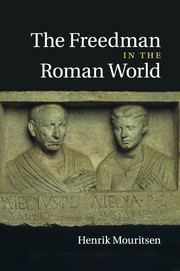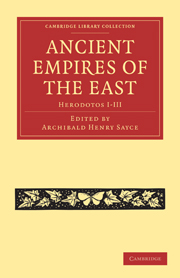Refine search
Actions for selected content:
23990 results in Ancient history
3 - Freedmen and their patrons
-
- Book:
- The Freedman in the Roman World
- Published online:
- 21 January 2011
- Print publication:
- 27 January 2011, pp 36-65
-
- Chapter
- Export citation
Contents
-
- Book:
- The Freedman in the Roman World
- Published online:
- 21 January 2011
- Print publication:
- 27 January 2011, pp v-v
-
- Chapter
- Export citation
Acknowledgements
-
- Book:
- The Freedman in the Roman World
- Published online:
- 21 January 2011
- Print publication:
- 27 January 2011, pp vi-vi
-
- Chapter
- Export citation
Frontmatter
-
- Book:
- The Freedman in the Roman World
- Published online:
- 21 January 2011
- Print publication:
- 27 January 2011, pp i-iv
-
- Chapter
- Export citation
8 - Being a Roman freedman
-
- Book:
- The Freedman in the Roman World
- Published online:
- 21 January 2011
- Print publication:
- 27 January 2011, pp 279-299
-
- Chapter
- Export citation
Index
-
- Book:
- The Freedman in the Roman World
- Published online:
- 21 January 2011
- Print publication:
- 27 January 2011, pp 335-344
-
- Chapter
- Export citation
5 - The practice of manumission at Rome
-
- Book:
- The Freedman in the Roman World
- Published online:
- 21 January 2011
- Print publication:
- 27 January 2011, pp 120-205
-
- Chapter
- Export citation
6 - The freedman in the Roman economy
-
- Book:
- The Freedman in the Roman World
- Published online:
- 21 January 2011
- Print publication:
- 27 January 2011, pp 206-247
-
- Chapter
- Export citation
Bibliography
-
- Book:
- The Freedman in the Roman World
- Published online:
- 21 January 2011
- Print publication:
- 27 January 2011, pp 300-334
-
- Chapter
- Export citation
7 - The freedman (and his son) in public life
-
- Book:
- The Freedman in the Roman World
- Published online:
- 21 January 2011
- Print publication:
- 27 January 2011, pp 248-278
-
- Chapter
- Export citation
2 - Macula servitutis
-
- Book:
- The Freedman in the Roman World
- Published online:
- 21 January 2011
- Print publication:
- 27 January 2011, pp 10-35
-
- Chapter
- Export citation
1 - Introduction
-
- Book:
- The Freedman in the Roman World
- Published online:
- 21 January 2011
- Print publication:
- 27 January 2011, pp 1-9
-
- Chapter
- Export citation

The Freedman in the Roman World
-
- Published online:
- 21 January 2011
- Print publication:
- 27 January 2011

Ancient Empires of the East
- Herodotos I–III
-
- Published online:
- 06 December 2010
- Print publication:
- 20 May 2010
- First published in:
- 1883

The Cambridge Companion to the Roman Historians
-
- Published online:
- 28 November 2010
- Print publication:
- 24 September 2009
APPENDIX I
-
- Book:
- Money in Classical Antiquity
- Published online:
- 05 August 2012
- Print publication:
- 18 November 2010, pp 199-205
-
- Chapter
- Export citation
Index
-
- Book:
- Money in Classical Antiquity
- Published online:
- 05 August 2012
- Print publication:
- 18 November 2010, pp 234-237
-
- Chapter
- Export citation
List of abbreviations
-
- Book:
- Money in Classical Antiquity
- Published online:
- 05 August 2012
- Print publication:
- 18 November 2010, pp xvii-xvii
-
- Chapter
- Export citation
Contents
-
- Book:
- Money in Classical Antiquity
- Published online:
- 05 August 2012
- Print publication:
- 18 November 2010, pp ix-ix
-
- Chapter
- Export citation
5 - Prices and price formation: issues
-
- Book:
- Money in Classical Antiquity
- Published online:
- 05 August 2012
- Print publication:
- 18 November 2010, pp 125-140
-
- Chapter
- Export citation
